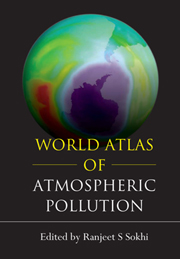Book contents
- Frontmatter
- Contents
- Contributors
- Foreword
- Preface
- Acknowledgements
- International Union of Air Pollution Prevention and Environmental Protection Associations (IUAPPA)
- Global Atmospheric Pollution (GAP) Forum
- Acronyms and Abbreviations
- Selected Units Used in Atmospheric Pollution Science
- INTRODUCTION
- CHAPTER 1 AIR POLLUTION HISTORY
- CHAPTER 2 AIR POLLUTION IN URBAN AREAS
- CHAPTER 3 LONG-RANGE TRANSPORT OF ATMOSPHERIC POLLUTANTS AND TRANSBOUNDARY POLLUTION
- CHAPTER 4 GLOBAL AIR POLLUTION AND CLIMATE CHANGE
- CHAPTER 5 OZONE DEPLETION
- CHAPTER 6 ENVIRONMENTAL AND HEALTH IMPACTS OF AIR POLLUTION
- CHAPTER 7 FUTURE TRENDS IN AIR POLLUTION
- References
- List of Useful Reading Material
- Index
CHAPTER 1 - AIR POLLUTION HISTORY
Published online by Cambridge University Press: 05 March 2012
- Frontmatter
- Contents
- Contributors
- Foreword
- Preface
- Acknowledgements
- International Union of Air Pollution Prevention and Environmental Protection Associations (IUAPPA)
- Global Atmospheric Pollution (GAP) Forum
- Acronyms and Abbreviations
- Selected Units Used in Atmospheric Pollution Science
- INTRODUCTION
- CHAPTER 1 AIR POLLUTION HISTORY
- CHAPTER 2 AIR POLLUTION IN URBAN AREAS
- CHAPTER 3 LONG-RANGE TRANSPORT OF ATMOSPHERIC POLLUTANTS AND TRANSBOUNDARY POLLUTION
- CHAPTER 4 GLOBAL AIR POLLUTION AND CLIMATE CHANGE
- CHAPTER 5 OZONE DEPLETION
- CHAPTER 6 ENVIRONMENTAL AND HEALTH IMPACTS OF AIR POLLUTION
- CHAPTER 7 FUTURE TRENDS IN AIR POLLUTION
- References
- List of Useful Reading Material
- Index
Summary
Although interest in indoor air pollution seems relatively recent, our earliest evidence of air pollutants often comes from indoor environments, such as dwellings filled with smoke and associated pollutants from poorly ventilated fires. When cities developed, these also became associated with pollution problems. The development of air pollution over the last 700–800 years seems to follow consistent patterns. Air pollution has often been related to the history of fuel use and the perceptible change in air pollution that arises from the fuels. Increasing energy demands and the adoption of new fuels (sequentially: coal, petrol, diesel) have caused air pollution problems. Mieck (1990) has argued that the numerous pollution decrees from the Middle Ages are essentially a response to single sources of what he terms pollution artisanale. These were usually just one particular type of pollution and distinct from the later and broader pollution industrielle that characterised an industrialising world.
Air pollution has often been visible as smoke, photochemical smog and diesel smoke. The concentration of air pollutants from a given source, such as coal, seems to increase for a long period and undergo a decrease due to declining emission strength. The pollution from one source is often replaced by another (e.g. coal smoke by petrol-derived pollution).The patterns of changing air pollution, although similar from one country to another, can take place over very different timescales.
- Type
- Chapter
- Information
- World Atlas of Atmospheric Pollution , pp. 7 - 18Publisher: Anthem PressPrint publication year: 2008
- 1
- Cited by



